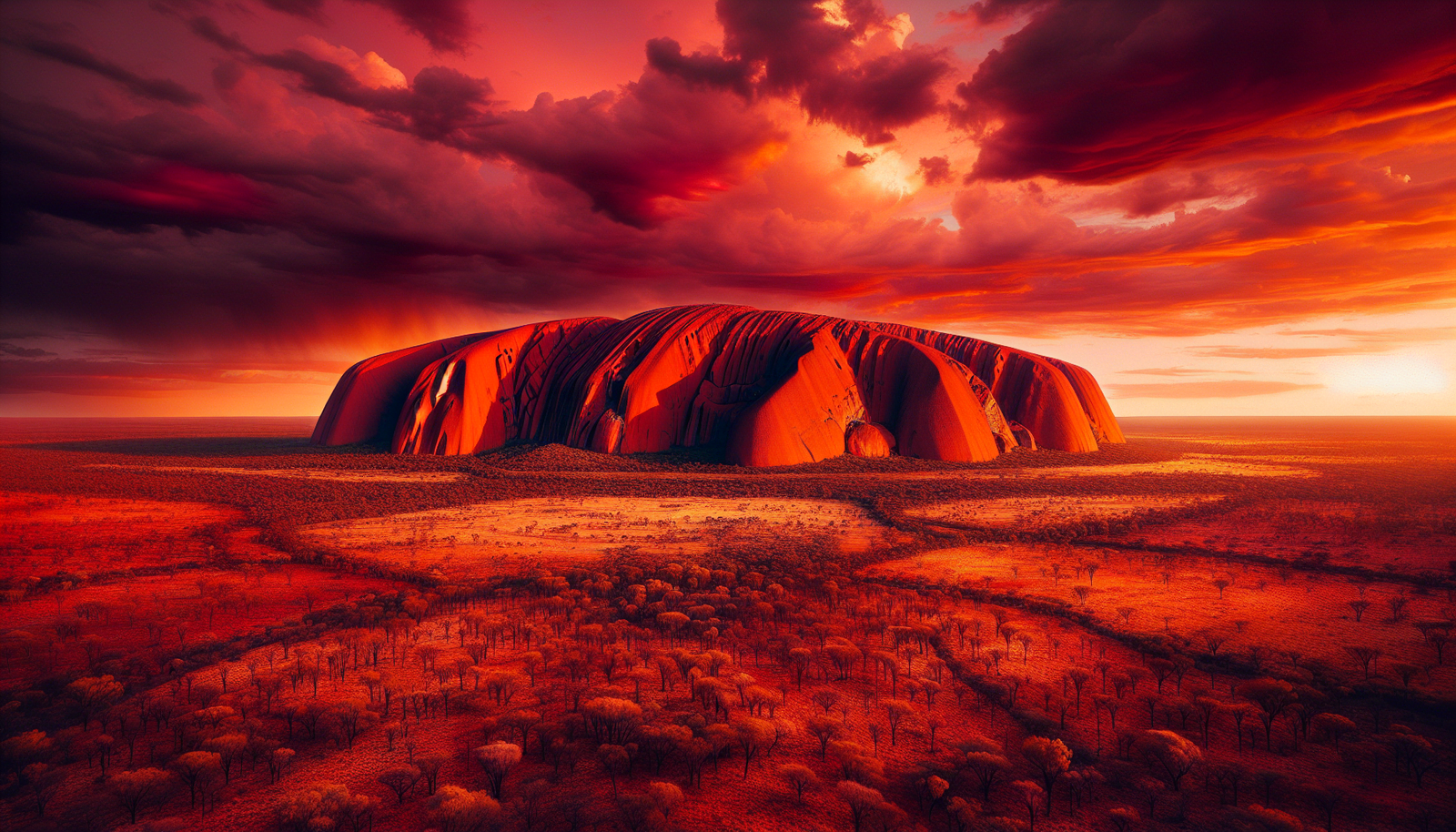In “Is Uluru The Biggest Rock In The World?”, you’ll embark on an exciting exploration into the intriguing world of geology. This fascinating journey will guide you through the breathtaking landscapes of Australia, as you discover the awe-inspiring majesty of Uluru. Along the way, we will put into perspective its size, and how it measures up against other phenomenal geological formations around the world. Brace yourself for an exhilarating and enlightening expedition, and prepare to be astounded by the grandeur and mysteries of Mother Nature’s phenomenal earthwork, Uluru.
Understanding Uluru
Definition of Uluru
Uluru, often known by its English name Ayers Rock, is a magnificent rock formation located in the heart of the Northern Territory’s arid “Red Centre” in Australia. It is an inselberg, essentially an island mountain, and notable for appearing to change colour at different times of the day, particularly the vivid red at dawn and sunset.
Location and surroundings of Uluru
Uluru is situated near the western end of the Simpson Desert, 208 miles southwest of Alice Springs (by road) and 335 miles west of the Queensland border. Its surroundings mostly comprise of vast, desolate desert and spinifex grasslands, which contributes to its striking aura of isolation.
Indigenous significance of Uluru
To the Aboriginal Anangu people, Uluru is an incredibly significant cultural site. They are the traditional owners of this land and they consider Uluru to be a deeply sacred place filled with spiritual energy from the time of their ancestors, which they refer to as the ‘Tjukurpa’ or ‘Dreaming’. The rock features many ancient rock art sites and the Anangu still perform rituals and ceremonies there today.
The Size of Uluru
Height Comparison with other structures and mountains
Stand in front of Uluru and it towers above at an impressive height of 348 meters, that’s higher than the Eiffel Tower, Sydney Tower and even Chrysler Building in New York City. However, compared to Mount Everest or the Burj Khalifa, the world’s tallest man-made structure, Uluru is still considerably smaller.
Length and width of Uluru
Uluru stretches to a large and impressive length and width, making it a massive spectacle from all angles. It measures about 3.6 kilometers long (from west to east) and 1.9 kilometers wide, quite impressive for a single piece of rock.
Overall volume of the rock formation
Another feature that makes Uluru unique is its enormous volume. Much of the bulk of Uluru is actually underground, with estimates suggesting that almost two-thirds of the formation extends beneath the surface. This means that the above-ground section represents only a fraction of its true mass.

Exploring Other Big Rocks Around the World
Mount Augustus in Australia
Another incredible rock formation in Australia is Mount Augustus. Located in Western Australia, Mount Augustus is actually larger than Uluru, rising to a majestic height of 715 meters and with a length of over 8 kilometers.
Rock of Gibraltar at the entrance of Mediterranean
Located at the entrance of the Mediterranean, the Rock of Gibraltar is an impressive limestone promontory. It stands 425 metres high, less than the height of Uluru, but its strategic location and biodiversity make it just as awe-inspiring.
El Capitan in the US
El Capitan, situated in Yosemite National Park in the US, is a granite monolith famous for its vertical face. While it’s three times the height of Uluru at 900 meters, much like Uluru, it changes colour, especially during golden hour when it transforms into a stunning pinkish hue.
Guatape Rock in Colombia
Guatape Rock, also known as La Piedra or El Penol, is a granitic rock formation in Colombia. It’s much smaller than Uluru at 200 meters tall, but it’s still a sight to behold due to its unusual shape and the dizzying 649 steps to reach the top.
The Unique Features of Uluru
Geological characteristics of Uluru
Geologically, Uluru is composed of arkose, a coarse sandstone rich in the mineral feldspar. This rock formation is hundreds of millions of years old, shaped by winds, rains and temperature over time.
Flora and fauna around Uluru
While one may think the barren landscapes around Uluru could not support much life, it is actually home to an array of flora and fauna. This includes 46 species of native mammals, 178 species of birds, 73 species of reptiles and over 400 plant species.
Changing colours of Uluru at different times of the day
One of the most magical things about Uluru is its ability to seemingly change colour throughout the day. The red hue can turn a golden bronze at dawn, a bright red at midday, and then a deep, dark red at sunset due to the oxides on the rock interacting with sunlight.

Comparison of Uluru with Mount Augustus
Comparative height and length
While both Uluru and Mount Augustus are iconic landmarks in Australia, Mount Augustus is nearly twice the height and over twice the length of Uluru. Mount Augustus stands at a height of 715m above the plain and is 8.1km long, compared to Uluru’s height of 348m and length of 3.6km.
Comparative geological features
Both Uluru and Mount Augustus are composed of sandstone, but Uluru’s rock is especially rich in feldspar, giving it its striking reddish hue. Both have been shaped over hundreds of millions of years, through geological forces and erosion.
Comparative cultural significance
The cultural significance of both these landmarks to the Indigenous communities cannot be overstated. While Uluru holds tremendous spiritual significance to the Anangu, Mount Augustus is a sacred site to the Wadjari Aboriginal people.
Comparison of Uluru with the Rock of Gibraltar
Comparative height and length
The Rock of Gibraltar, although impressive in its geographical makeup and biodiverse ecosystem, is not as tall as Uluru. The rock stands at 425m high, compared to Uluru’s 348m. However, the length of the Rock of Gibraltar is far shorter, stretching only 426m across.
Comparative geological features
The Rock of Gibraltar is mainly limestone, which is softer than the arkose sandstone of Uluru, and has a very different weathering pattern. While Uluru is famous for its color-changing capacity, the Rock of Gibraltar is known for its strategic location and its caves.
Comparative cultural significance
The Rock of Gibraltar has been inhabited by humans for tens of thousands of years and holds a significant place in mythology. It is traditionally known as one of the Pillars of Hercules. Uluru, while holding deep spiritual significance for the Anangu people, doesn’t have the same breadth of cultural history spanning across different cultures.

Comparison of Uluru with El Capitan
Comparative height and length
El Capitan in the US’s Yosemite National Park is an imposing granite monolith that is approximately three times taller than Uluru. El Capitan stands at 900m high, much taller than Uluru’s 348m, and its sheer granite face presents a striking contrast to Uluru’s domed sandstone formation.
Comparative geological features
While Uluru is an arkose sandstone formation rich in feldspar, El Capitan is a granite rock. Both are awe-inspiring in their own ways, with the sheer granite face of El Capitan offering a stark contrast to the rounded, weathered features of Uluru.
Comparative cultural significance
Both El Capitan and Uluru hold significant meanings in their respective cultures. El Capitan is a sacred site for several Native American tribes of the region. While the cultural significance may be a point of similarity with Uluru, the spiritual beliefs and traditions tied to each site are unique to the respective Indigenous communities.
Comparison of Uluru with Guatape Rock
Comparative height and length
Compared to Uluru, Guatape Rock in Colombia is quite small. It stands at approximately 200m tall and has a total length of approximately 385m, which is significantly smaller than Uluru’s 348m height and extensive 3.6km length.
Comparative Geological Features
Guatape Rock is a granitic rock, which is more resistant to erosion than Uluru’s sandstone. Despite the difference in their compositions, both rocks are striking due to their unusual shapes and sizes.
Comparative cultural significance
While Uluru is a sacred site for the Anangu people, Guatape Rock does not have the same level of spiritual significance. Instead, it’s more commonly known for its 649-step staircase and spectacular views.

Scientific Measures Employed in Rock Size Determination
Methods used to measure rock size
There are various scientific methods used to measure the size of a rock formation. These generally involve direct measurements of length, height, and width, or the use of satellite imagery and topographic maps. More recently, Lidar technology (Light Detection and Ranging) is used to create accurate 3D models.
Challenges in rock measurement
Several challenges can come with measuring the size of rock formations. These include gaining access to certain parts of the rock, weather conditions, and the complexity of the rock’s shape. There are also debates within the scientific community about what constitutes the ‘actual size’ of a rock, such as if the below-ground part should be included.
How Uluru’s size was determined
Uluru’s size was determined through several scientific methods, including direct measurements and studies of topographic maps. Using these methods, scientists have been able to ascertain its above-ground dimensions and estimate the portion that lies below the ground.
Conclusion: Is Uluru the Biggest Rock?
Summary of Uluru’s size in comparison with other rocks
While Uluru is massive, it isn’t technically the biggest rock in the world. It’s smaller than Mount Augustus in terms of both height and length. It is taller than Rock of Gibraltar, but considerably shorter than El Capitan, and significantly bigger than Guatape Rock.
Determination factor for ‘biggest’ rock
Determining the ‘biggest’ rock depends on what aspects you’re considering. If it’s by height, then El Capitan could be considered the ‘biggest’. If considering length or width, Mount Augustus takes the cake. However, if it’s about the total volume (including underground parts), Uluru could be a strong contender.
Uluru’s standing in the hierarchy of largest rock formations
While Uluru might not be the ‘biggest’ rock by certain measures, it is undoubtedly one of the most iconic. Its stunning geology, spiritual significance, and dramatic color changes throughout the day make it a favorite among locals and tourists alike. So, while it might not top the charts in sheer size, it holds its own in terms of cultural significance and beauty.








